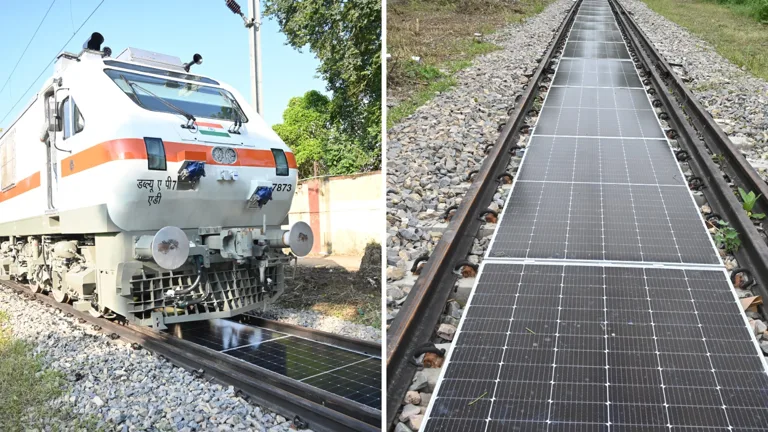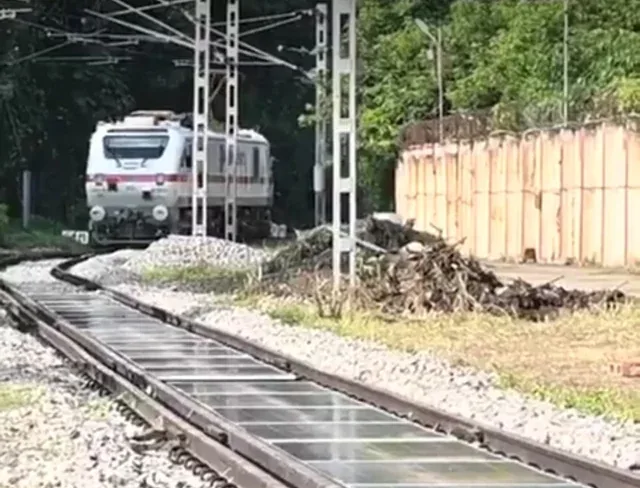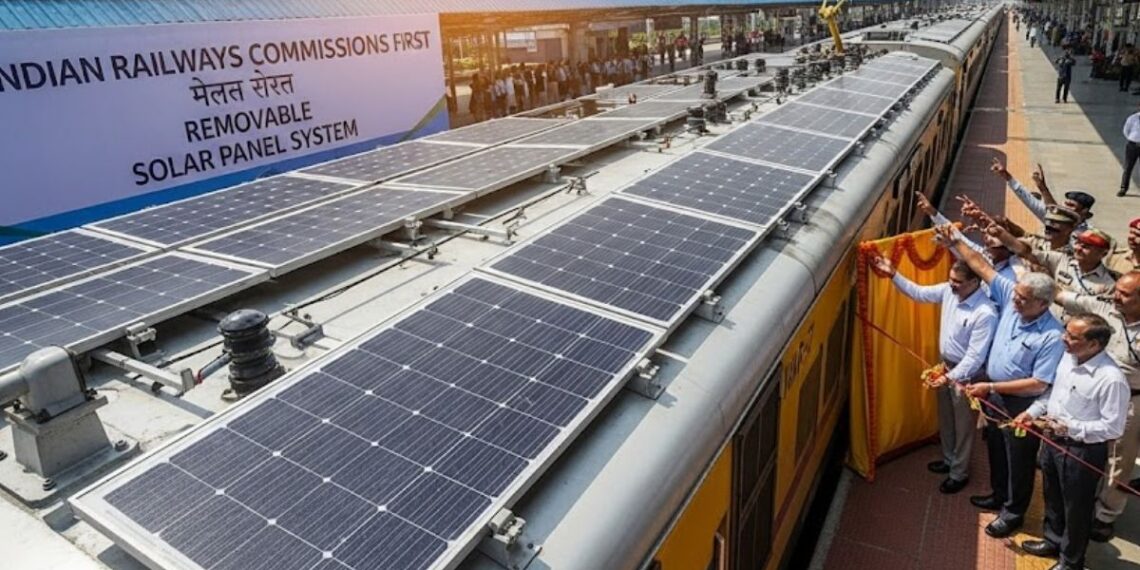Indian Railways has achieved a groundbreaking milestone in sustainable transportation by commissioning India’s first removable solar panel system between railway tracks at Banaras Locomotive Works (BLW), Varanasi. This innovative pilot project, unveiled on Independence Day 2025, represents a revolutionary approach to clean energy generation that could transform the future of railway operations across the country’s vast 1.2 lakh kilometer network.
Table of Contents
BLW Varanasi Solar Project: Indian Railways Complete Technical Specifications
| Project Details | Information |
|---|---|
| Location | Banaras Locomotive Works (BLW), Varanasi |
| Launch Date | August 15, 2025 (Independence Day) |
| Announcement Date | August 19, 2025 |
| Track Length | 70 meters (Line No. 19, BLW workshop) |
| Number of Panels | 28 bifacial monocrystalline solar panels |
| Power Capacity | 15 kWp (Kilowatt peak) |
| Daily Energy Generation | 67 units per day |
| Power Density | 220 kWp per kilometer |
| Energy Density | 880 units/km/day |
| Annual Potential | 3.5 lakh units per kilometer |
| Panel Type | Removable using 4 stainless steel Allen bolts |
| Maintenance Feature | Quick disassembly for track maintenance |
Revolutionary Design: Why Removable Panels Matter
The genius of this system lies in its removability. Each panel can be removed using four stainless steel Allen bolts, making disassembly quick and tool-friendly. This innovative design ensures that railway maintenance operations remain uninterrupted while maximizing clean energy generation from unutilized track space.

Key Technical Advantages
Space Optimization: The pilot project involves installing removable solar panels on sleepers and support beams under the tracks without disrupting rail traffic.
Indigenous Innovation: The system features indigenously designed installation process, showcasing India’s growing capabilities in green technology manufacturing.
Maintenance Efficiency: Unlike traditional solar plants, this system is designed to be removable, allowing railway workers to carry out routine maintenance or adapt the setup seasonally.
For more insights into India’s renewable energy initiatives and transportation innovations, explore our comprehensive green technology coverage on TechnoSports.
Massive Scale Potential: Transforming 1.2 Lakh Kilometers
The implications of this pilot project are staggering. Indian Railways operates across a colossal 1.2 lakh kilometers of track, presenting enormous potential for clean energy generation without additional land acquisition.
Projected Impact at Scale
If implemented across the entire railway network, this technology could generate:
- 42 billion units annually (based on 3.5 lakh units per kilometer)
- Significant carbon footprint reduction supporting India’s net-zero goals
- Reduced dependence on conventional electricity sources
- Cost savings in operational expenses
Supporting India’s 2030 Net-Zero Goals
This initiative aligns perfectly with Indian Railways’ commitment to achieving net-zero carbon emissions by 2030. Indian Railways installs India’s first removable solar panel system on tracks at BLW Varanasi, boosting its 2030 net-zero goal.
Environmental Benefits
The technology offers multiple environmental advantages:
- Zero Land Acquisition: Utilizes existing track infrastructure
- Clean Energy Generation: Reduces reliance on fossil fuels
- Carbon Emission Reduction: Supports national climate commitments
- Sustainable Operations: Powers railway stations and operations
Stay updated with the latest environmental initiatives and green transportation developments through our sustainability coverage for exclusive insights into India’s eco-friendly innovations.

Technical Innovation: Bifacial Monocrystalline Technology
The installation includes 28 bifacial monocrystalline solar panels spanning 70 metres with a total capacity of 15 kWp. This advanced technology captures sunlight from both sides, maximizing energy efficiency even in the confined space between railway tracks.
Future Expansion Plans
Indian Railways has planned to install 960 railway stations with solar panels to sustain their power generation needs, indicating the organization’s commitment to comprehensive renewable energy adoption.
Strategic Implementation
The success of this pilot will determine:
- Nationwide rollout across major railway routes
- Integration with existing railway infrastructure
- Scaling strategies for different track configurations
- Economic viability for large-scale implementation
Economic and Operational Impact
This innovative approach eliminates the need for separate land acquisition while generating substantial clean energy. The removable design ensures minimal disruption to railway operations while maximizing energy output from underutilized spaces.
The project demonstrates how creative engineering solutions can address multiple challenges simultaneously: energy needs, environmental concerns, and operational efficiency.
For the latest updates on Indian Railways innovations and green energy initiatives, visit DD News Railways and Ministry of Railways Official for comprehensive coverage.
Frequently Asked Questions
Q1: How much electricity can the removable solar panel system generate?
A1: The 70-meter pilot installation at BLW Varanasi generates 67 units of electricity daily with a capacity of 15 kWp. If scaled to 1 kilometer, the system can generate up to 3.5 lakh units annually, with power density of 220 kWp/km and energy density of 880 units/km/day.
Q2: How are the solar panels removed for track maintenance?
A2: Each solar panel can be quickly removed using four stainless steel Allen bolts, making disassembly tool-friendly and efficient. This removable design ensures railway maintenance operations can proceed without delay while preserving the solar infrastructure for reinstallation.








